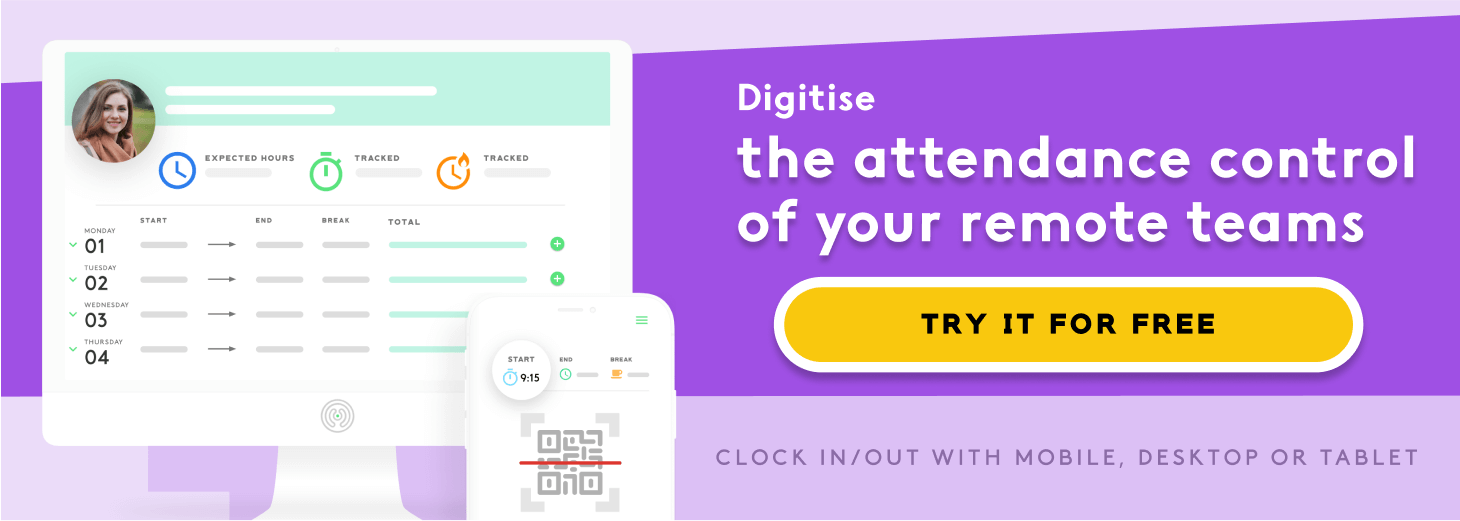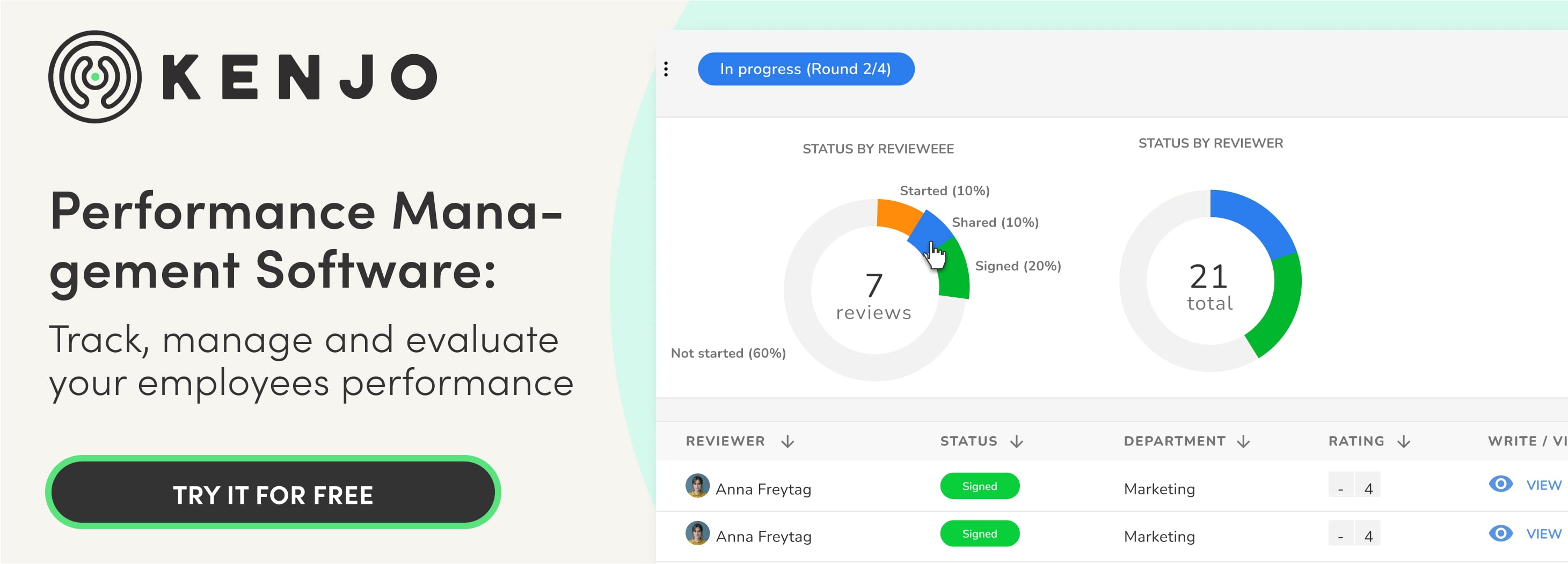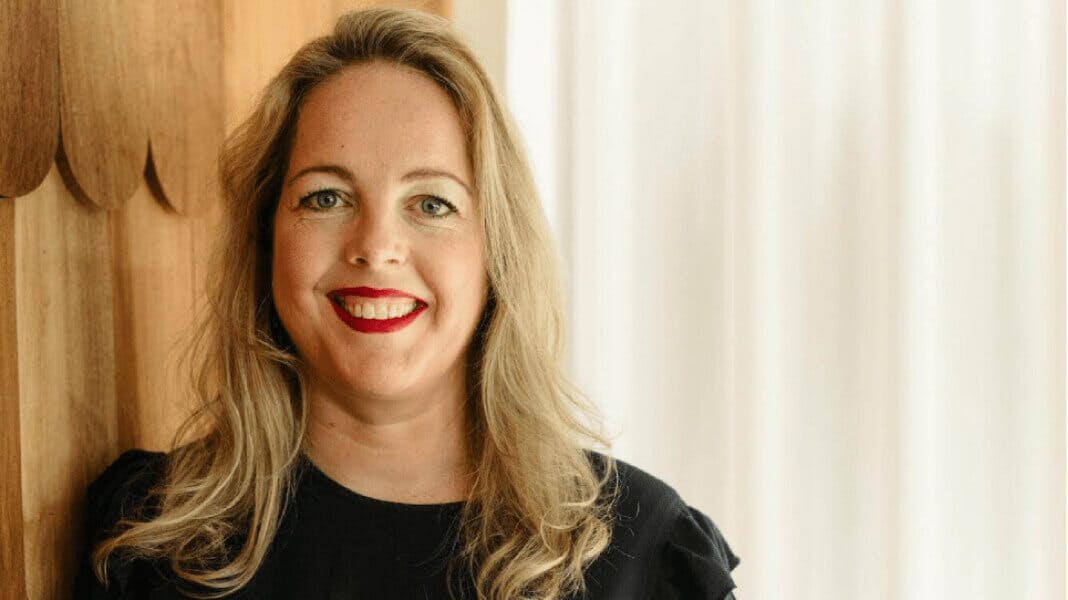What is HR software?
HR software is a digital solution that enables you to manage and optimise the people department’s daily tasks and make it easier to achieve the organisation’s objectives.
Using an online HR software usually saves a huge amount of time as processes become automated. In parallel, it also enables you to improve resource planning and organisation (of people, time and budgets).
It also helps you improve your decision-making. For example, HR software enables you to see how many employees will be needed to cope with the workload at certain times of the year, based on historical data.
What does HR software do?
HR software has been created to help the human resources department in their daily tasks through automation, organising information and creating automatic reports. And on top of all that, you can access cloud HR software from anywhere, and with any device.

The main advantage of HR management software is that it integrates all of these features in one single platform. What's more, it also connects all the information, so it's always updated and available for the team in real-time.
Benefits of implementing HR software
While a small company's needs will be different from those of a larger one, thebenefits of using HR software systemsare the same. Let's take a look at them:

1. Increases the human resources team’s efficiency
One of the immediate benefits of using HR management software is that the department will become more efficient. Repetitive and manageable tasks can be automated, and others, such as approving holidays and leave, can be delegated to team leaders through the platform itself. According to a study by KPMG (2019), 88% of HR professionals who have invested in digitalisation felt it was well worth it.

2. Enhances the employee experience
New technological advances mean that we have become used to using our mobiles for practically everything. So it's perfectly normal that employees expect to use their phone for requesting holidays, consult their payslip or for clocking in and out.
HR software for small businesses also improves communication between employees and the department. After all, it's a new channel both parties can use to send requests, notifications, etc.

3. Helps you optimise resources and save money
Implementing a cloud HR software obviously means covering the cost of the licence. Nevertheless, in the mid to long term, this type of platform allows you to distribute resources more efficiently and save time, not only for the HR department but for the company as a whole. You can save up to 40% of the time spent on administrative tasks through Kenjo, for example.

4. Helps you make better decisions
The human resources department works with a huge amount of data. Still, its potential is often wasted because it doesn’t have the appropriate tools and knowledge.
The advantage of working with HR software is that it enables you to generate, research and analyse reports regarding key metrics for the organisation. You can quickly and easily test a different hypothesis and, as a result, make timely and accurate decisions.

5. Enables compliance with data protection regulations
This aspect of people department's work becomes so much easier because online HR software is constantly updated with the latest data protection regulations. These systems apply the necessary security and protection measures as well as requesting the authorisations needed to store and use company and employee information.

6. Increases data security
Many companies still store their employees’ personal data in physical files, something that now violates security regulations. In contrast, cloud-based software protects this information from theft, fire and flooding. It also incorporates complex and sophisticated encryption systems that block possible cyberattacks.
Test: Do you need a HR Software?
Kenjo has created a fun test to help you gauge the current situation in your company’s HR department. Answer the questions to find out whether you need HR software to help your daily workload.
The rise of cloud-based HR software
Cloud-based technology has experienced unstoppable growth in recent years and particularly in 2020, which has been characterised by remote working. According to an article shared by Forbes, 32% of IT budgets will be dedicated to cloud-based services by 2021.
So, the cloud has become a home for software that offers solutions to problems and business requirements. These naturally include human resources software which has been gaining ground over office-based solutions.
What are the differences between one or the other? To start with, you don’t need to install cloud-based software on your computer. So they don't take up memory space, and you don't run the risk of losing information if the device breaks down while you're using it.
On that note, accessibility is another crucial factor. While you can only access office-based programs through the computer it is installed on, you can access the cloud from any device with just an internet connection.
Security is another differentiating factor. In the office, the user is responsible for doing backups and protecting the information. With software platforms today, suppliers have access to a wide range of technological resources, so they take responsibility for guaranteeing your data is secure.
HR software systems are generally more economical, easier to implement, and you won’t need to install new versions manually.
So, in summary, a cloud-based platform:
- Doesn't require installation.
- Is easy to implement and user-friendly.
- Can be accessed from any device with an internet connection.
- Is far more secure.
Which types of HR software are available on the market?
There is a wide range ofERP systems for HRto choose from. You find specific solutions for payroll, timekeeping, recruitment, for example, as well as others that combine many of these features to offer a more comprehensive and integrated solution.
So, how do you know which one to choose? The first thing to consider isthe size of your company, as the HR team's requirements will be different depending on the number of employees. Getting the timing right and choosing the best tool is crucial to avoid investing in an underused solution, or lose the chance to optimise and improve departmental operations.
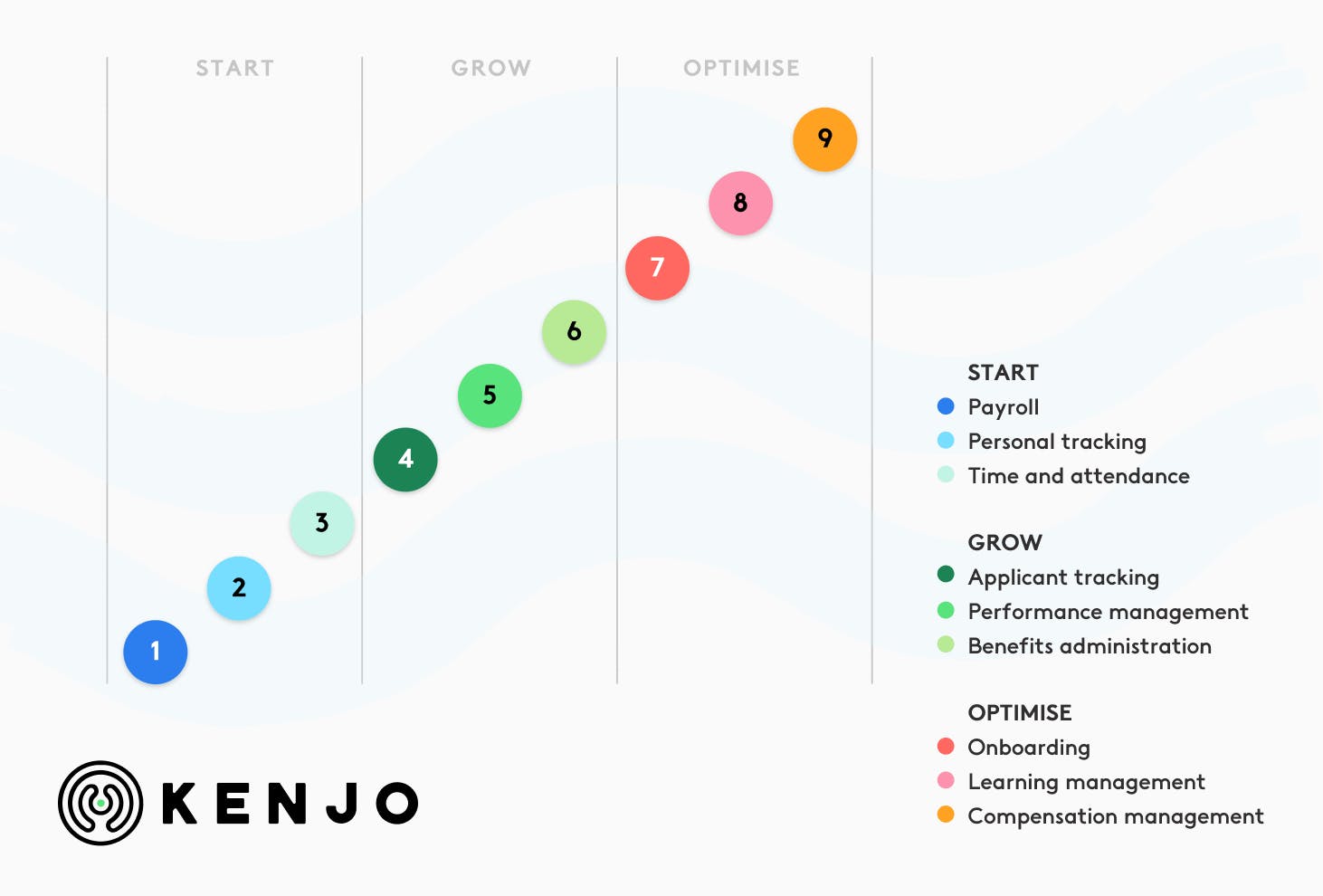
This image by softwareadvice shows a range of useful features for HR, depending on the phase of startup development, growth or optimisation.
Human resources information system (HRIS)
A Human resources information system or HRIS software combines a series of useful features to lighten your team's day-to-day workload. For example:
- Absence management.
- Employee portal.
- Recruitment and selection systems.
- Reports and analytics.
This kind of system aims to digitise internal processes, and especially the data and documentation that you work with on every day. This ensures that information is protected and connected in a single platform, making it much easier for the HR team to work with.
Human capital management software (HCM)
A human capital management software or HCM helps with the acquisition, management and optimisation of an organisation’s workforce. This tool helps you drive commitment, productivity and business value.
In other words, it is software that integrates features that are directly related to people management, and which has people at its core.
For example, this kind of software has been created to design and implement onboarding processes, evaluate employee performance or handle training programmes and internal development.
Human resources management system (HRMS)?
Human resources management systems, or HRMS, are designed to manage, digitise and automate all the HR department’s processes. So it helps you monitor the activity and needs of company employees, store information, and use it for your analysis and decision-making. It's one of the most comprehensive systems on the market as it includes practically everything that the team meets to manage the company's workforce. What's the difference between these three different types of software? This lies mainly in the features and services each one offers. HR expert Mark Maiorino illustrates this in this table:
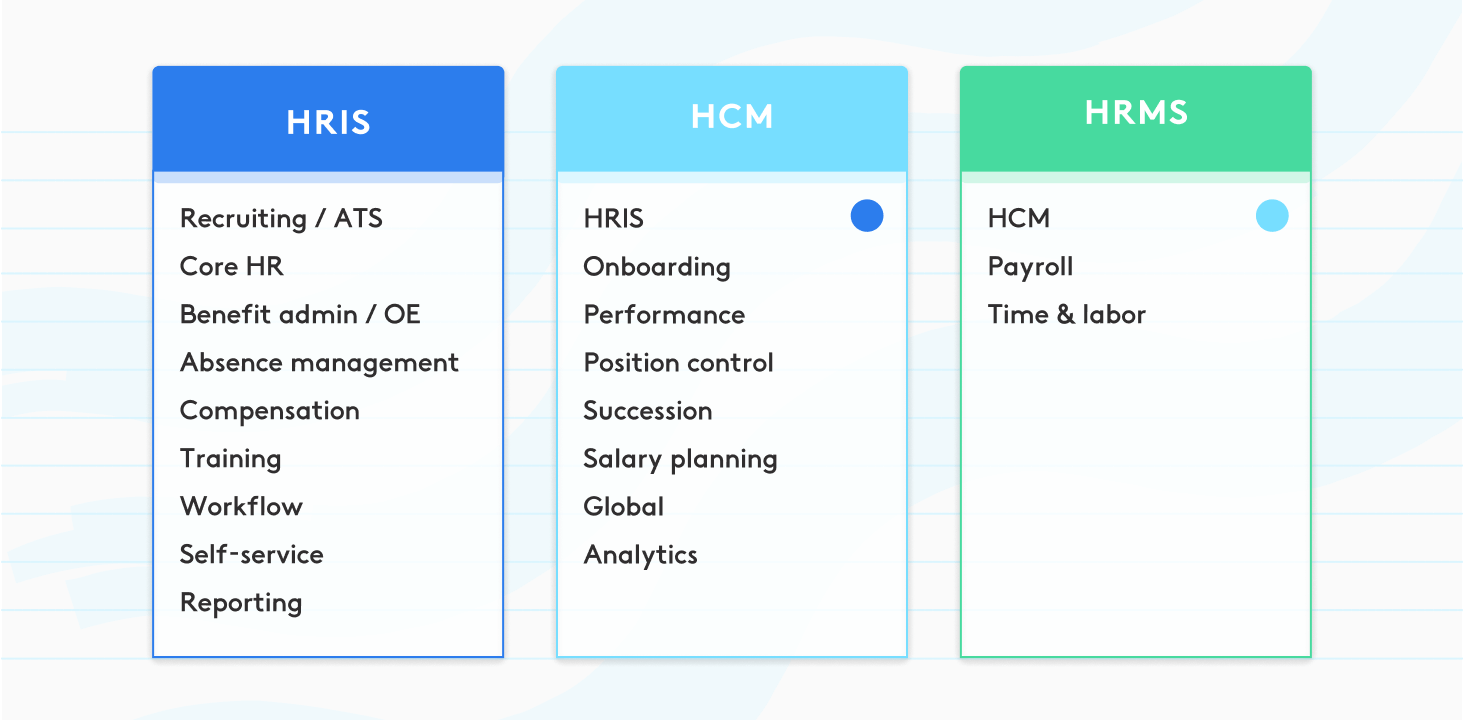
HR management software: features to watch out for
When it comes to digitising the personnel department and choosing HR management software, an “all-in-one” solution is the best choice. Or rather, a platform that incorporates as many tasks as possible, therefore offering significant time savings for the team so that they can focus on more strategic issues.
Let’s take a look at some of the most important features below:
Absence and leave management
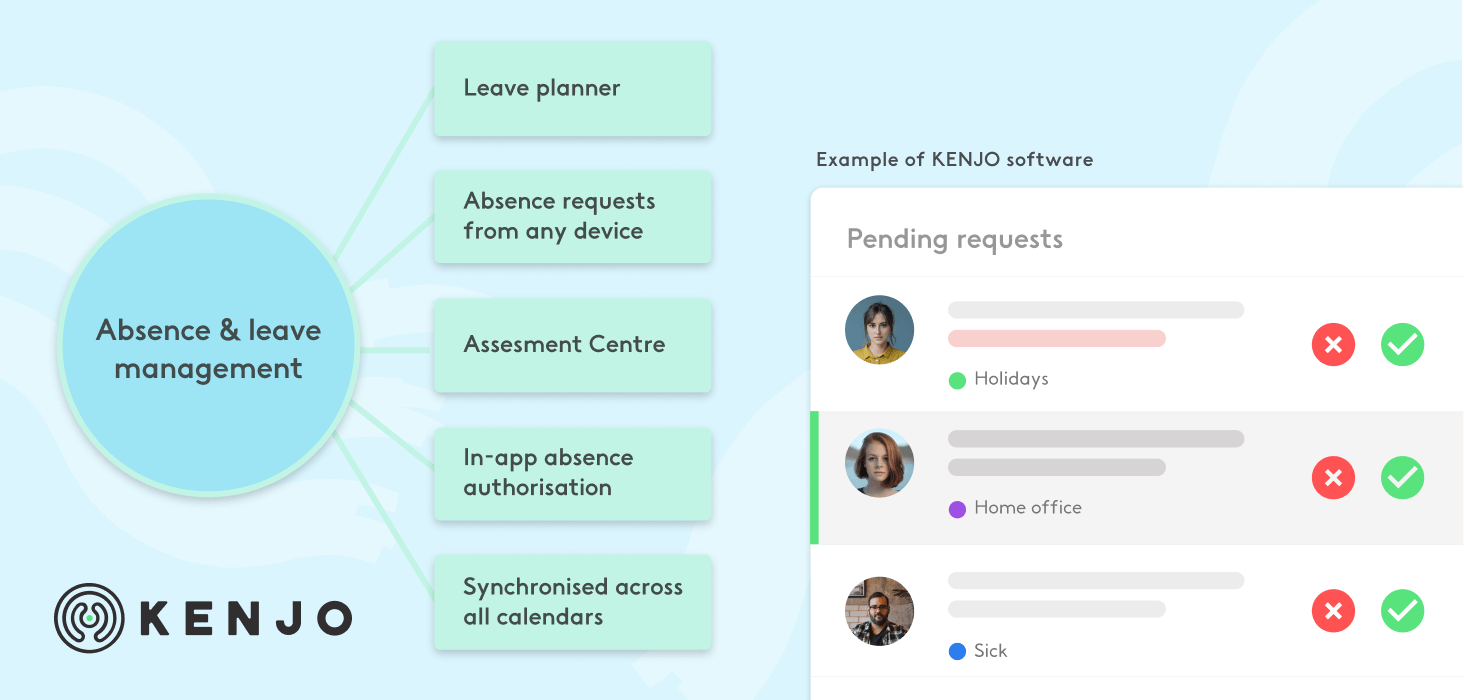
Absence and leave management can becomeone of the HR department’s most monotonous tasksif the right tools aren’t in place. Employees normally send emails for requesting holidays, notifying their absence or sending the respective authorisations. This is not only conducive to errors, but it's also very inefficient.Absence and leave management software, on the other hand, centralises all these requests and streamlines internal processes.
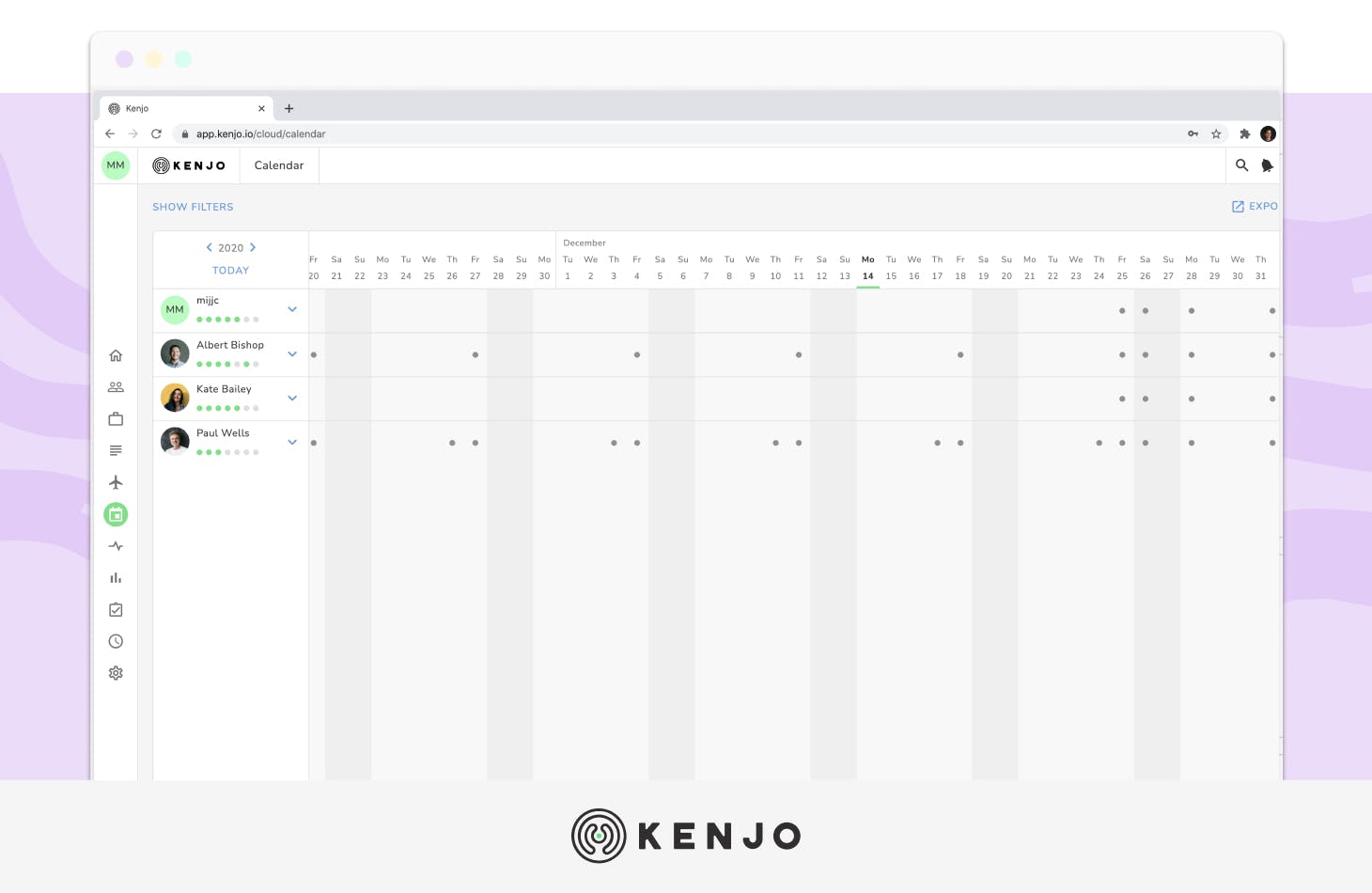
Real-life example of our software
Leave planner
Once information such as absences, holidays, sick leave or maternity/paternity leave is in the system, it will automatically generate a calendar where you can see who is active on any given day. This gives you a clear, visual summary that helps you decide whether you need extra cover in any area, or stop authorising holidays on specific dates to avoid being understaffed.
Absence requests from any device
Employees can communicate their absences to the human resources department and their direct manager from any device. So, should anything arise at the last minute, they can notify the company quickly and easily.
Features such as Kenjo’s absence management app offer you the possibility to create absence authorisation processes from any device. You can even create double validation processes when two people need to authorise employee requests.
In-app absence authorisation
Likewise, the person responsible for approving holiday and absence requests can respond automatically via their mobile or computer. So, there’s no need for endless emails or telephone calls as all communication takes place through one platform.
Synchronised absences across all calendars
Who has requested holidays during the last two weeks of August And who has booked Easter off? Being able to visualise who will be on holidays at any given moment comes in extremely handy when coordinating your team. This is why so many human resources systems integrate with calendars (like Google or Microsoft) to share this information across popular apps.
Time tracking software
All UK and European companies became obligated to keep records of each employee's working hours in 2016. These rules are there to limit the number of hours employees work and ensure they are paid for any overtime. It is up to the company to choose which time-tracking system they use. Nevertheless, human resources software that includes specific time-tracking features is by far the best choice, because it can adapt to almost any kind of business.
What is an employee attendance app, and why should you use one? Employee attendance apps enable employees to clock in from any device effortlessly, and the HR department receives this information automatically. This software also allows the team to identify employees who are doing more overtime, record absences or spot areas that may need more cover.
Kenjo's employee attendance app provides all the features you need to comply with employment law and control of employee attendance whether they’re working in the office, in a factory or from home. The most popular features in Kenjo’s HR management software are:
Digital timekeeping from any device
Some systems allow employees to clock in and out from any device. This leaves employees free to clock in and out, whether they’re working remotely or visiting a client. GPS technology also enables you to see where the employee was at the time they did so.
All this information is recorded on the platform. The HR team can check this whenever necessary, and it will also be stored for four years in line with European law.
Overtime compensation
As we mentioned earlier, the objective of the law is to ensure that employees are paid for any overtime worked. As the software keeps such an exhaustive record of working hours, ensuring payslips are accurate and exchanging extra hours for holidays will become way more manageable.
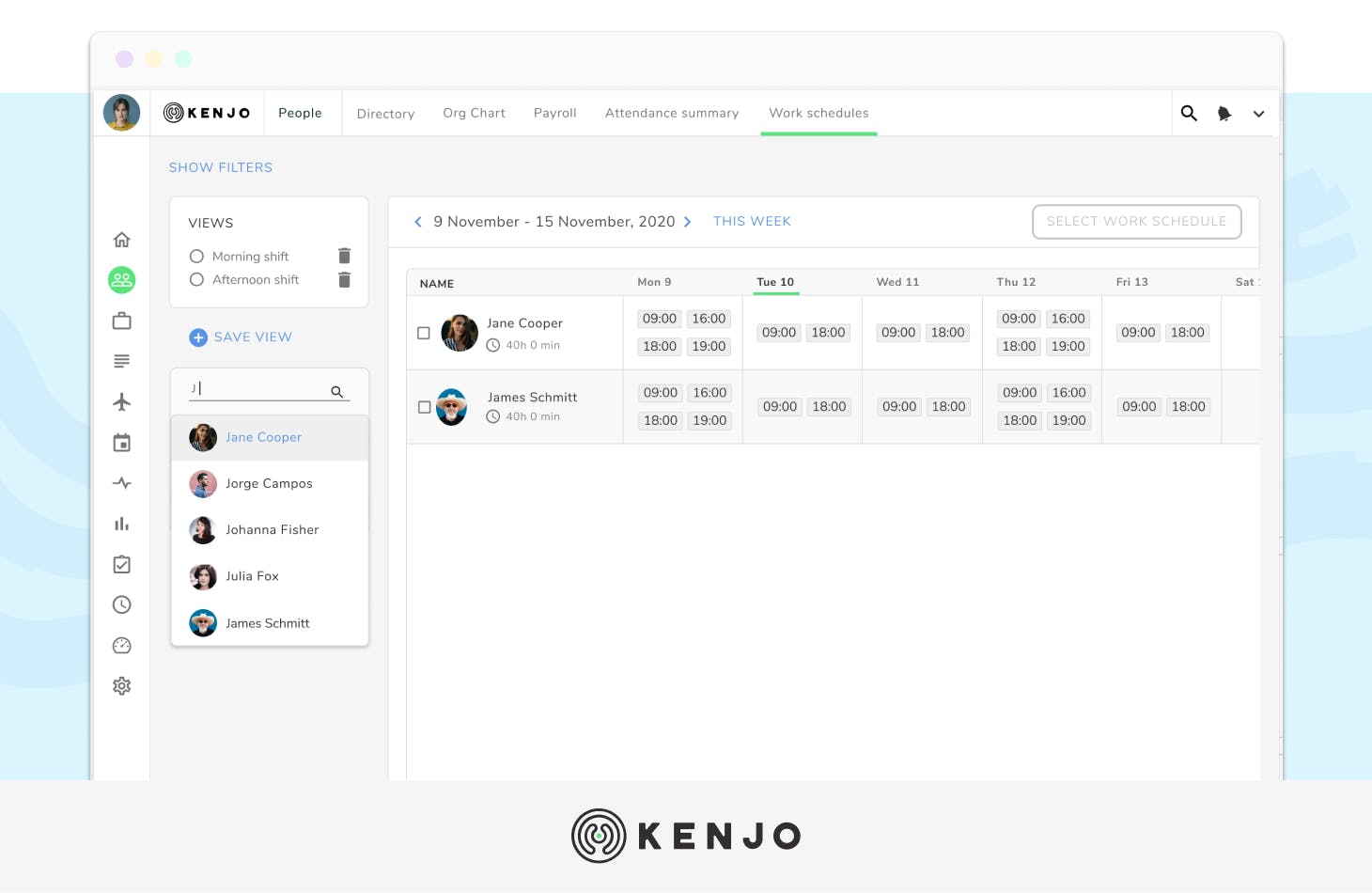
Real-life example of our software
Clock-in kiosk with QR code image
Traditional biometric readers using fingerprints or magnetic swipe cards are no longer secure in times of COVID-19. No official legislation has been implemented in the UK, but workers' unions are issuing advice on the use of a clocking-in device that involves touch.
So, what’s the best alternative? Well, there are many. But the safest and most convenient is to clock in and out with mobile using a simple photo or QR code.
Performance review system
In the book La gestión de Recursos Humanos (Human resources management, 2007) by S. L. Dolan, R. Valle Cabrera, S. E. Jackson and R.S. Schuler, the performance review is defined as: “a structural and systematic procedure to measure, assess and influence the attributes, behaviour and results related to work, with the aim of discovering how productive an employee is, and if their future performance could be improved.”
This method is used today, in particular, to foster employee growth and development, and at the same time, to ensure that business objectives are achieved. So, it’s an important process that must be developed in the most objective and coherent way possible.
Ultimately, it's about motivating employees and ensuring that they become more efficient in day-to-day tasks. While it's true that this is difficult to measure, HR productivity software will help us find a system that best suits your business.
Kenjo is one of few all-in-one platforms on the UK and European market that has a performance review module with scope for 180º, 270º and 360º degree feedback processes. You can see some of the features of Kenjo’s performance review software below:
180º, 270º and 360º performance reviews
There are different types of performance appraisals, and they mainly differ in terms of the people who are invited to give feedback.
In the 180-degree performance review, a professional is evaluated by their manager, their teammates and, where applicable, their clients. The 270º feedback method is where the employees give their opinion about their line manager. Lastly, the 360º feedback method is where managers, teammates, clients and suppliers are involved.
As there are so many people involved in the process: the HR department has to contact them, send out questionnaires, collect information, etc. And this takes a lot of work. The software, on the other hand, automatically sends the questionnaires and filters the information for you.
Talent matrix
A talent matrix or competency matrix is a tool that helps you balance team performance and foster skills development. The matrix illustrates the skills that are desired, available and those that the team doesn't possess. It's particularly useful in defining processes or creating new teams.
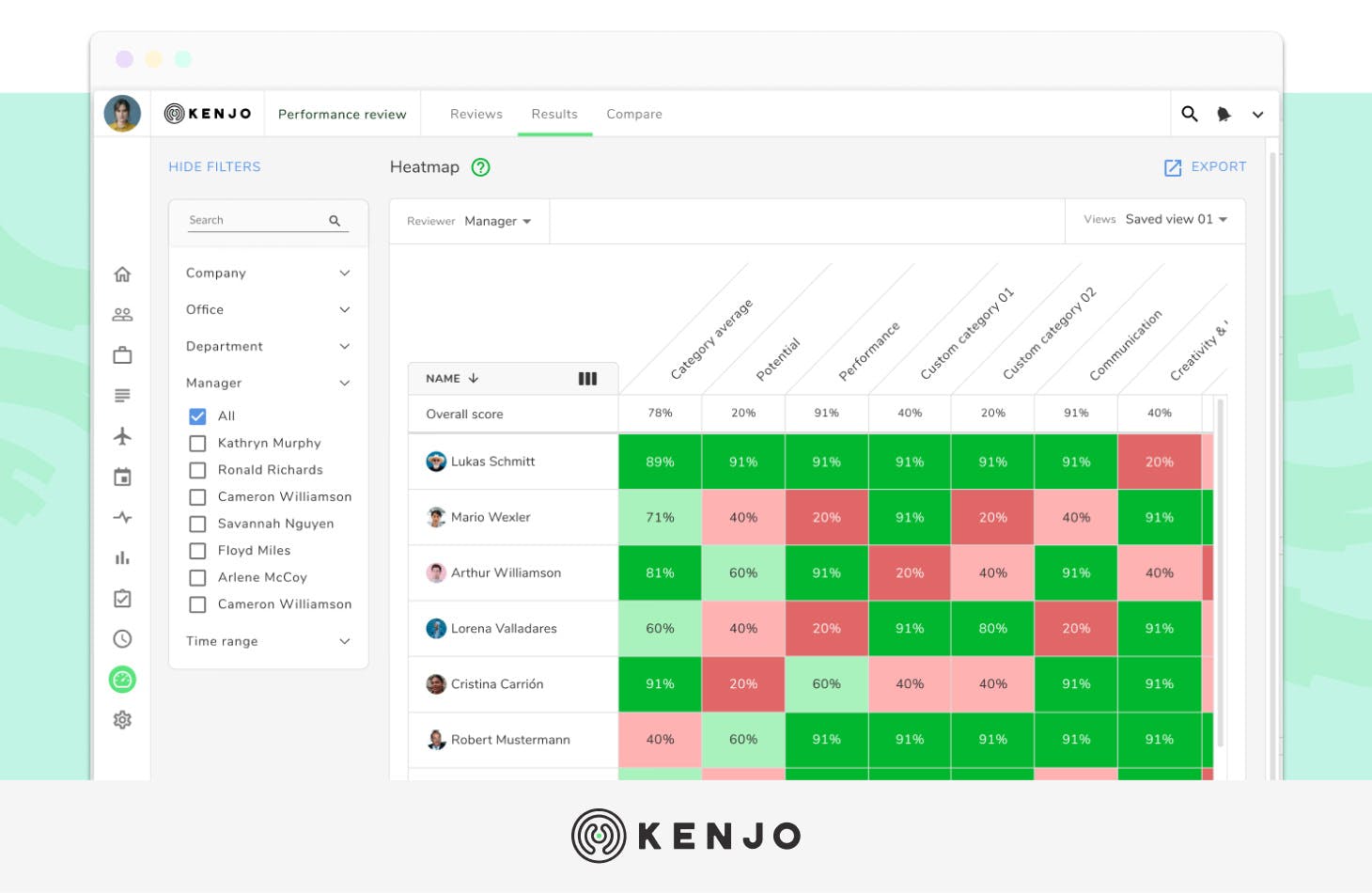
Real-life example of our software
Continuous and anonymous feedback
Human resources software can also be useful for opening a continuous and anonymous internal feedback channel in the company. You can automate and send regular surveys to follow up on employee development or identify potential issues in advance.
OKRs
OKR stands for Objective and Key Results. A management by objectives system, it's used by teams to achieve ambitious goals through a framework that requires regular monitoring, continuous learning and problem-solving. It's a simple but very useful system for executing strategies and pinpointing where to focus your efforts.
As the name suggests, the OKR methodology consists of an objective and key results that confirm if you're on the right path. The process of developing OKRs for the company or employees is quite simple, but you have to be thorough if it's going to work.
This kind of software enables you to record these objectives, easily track them and also, store the information to create a performance record for each employee.
Recruitment and selection
All companies carry out selection processes to cover job vacancies at some point or other. This means publishing the job opportunity on different portals, filter CVs, organise and carry out interviews, etc. In other words, it’s a lot of work.
One way of making recruitment processes easier is to use an Applicant tracking system (ATS). This acts as a CV database for the HR department and is on hand whenever needed. So it'll be much easier for you to organise, filter and select the candidate that best suits your organisation's needs.
So, you could say that ATS software lightens HR’s workload when it comes to finding new talent.

Real-life example of our software
Sourcing candidates through job portals
When choosing software, make sure it will connect to some of the main job portals: LinkedIn, Totaljobs, Indeed, etc. This means you can publish offers directly from your platform without having to do it through each portal individually. On the one hand, this saves you a huge amount of time and, on the other, centralises all applications ready for the filtering stage.
CRM for candidates
This software enables you to store candidate information and also create a record for any comments or documents you wish to attach. This is handy because anyone in your team will have access to observations made by the interviewers who met them, the reasons they were rejected and those that were eventually selected. It’s a great way of keeping information organised and accessible.
Jobs page
Having a jobs page on the company's website is the most economical way of capturing talent. Publish existing vacancies and also provide a form so that candidates can send their CV at any time. With this software, you’ll be able to manage, update and receive all requests in the same inbox too.
At the same time, a jobs page reinforces employer branding which, in turn, helps attract more candidates.
Scorecards
Scorecards are the most effective way to combat bias and subjectivity during interviews. This tool acts as a control panel for standardising the evaluation. This ensures that interviewers ask all candidates the same questions and rate their answers on a predefined scale. So, in other words, it’s a template that needs to be completed for each candidate.
Once the interviews are over, recruiters can check each candidate’s scores and compare the results. In theory, one with a higher score is the best fit for the role.
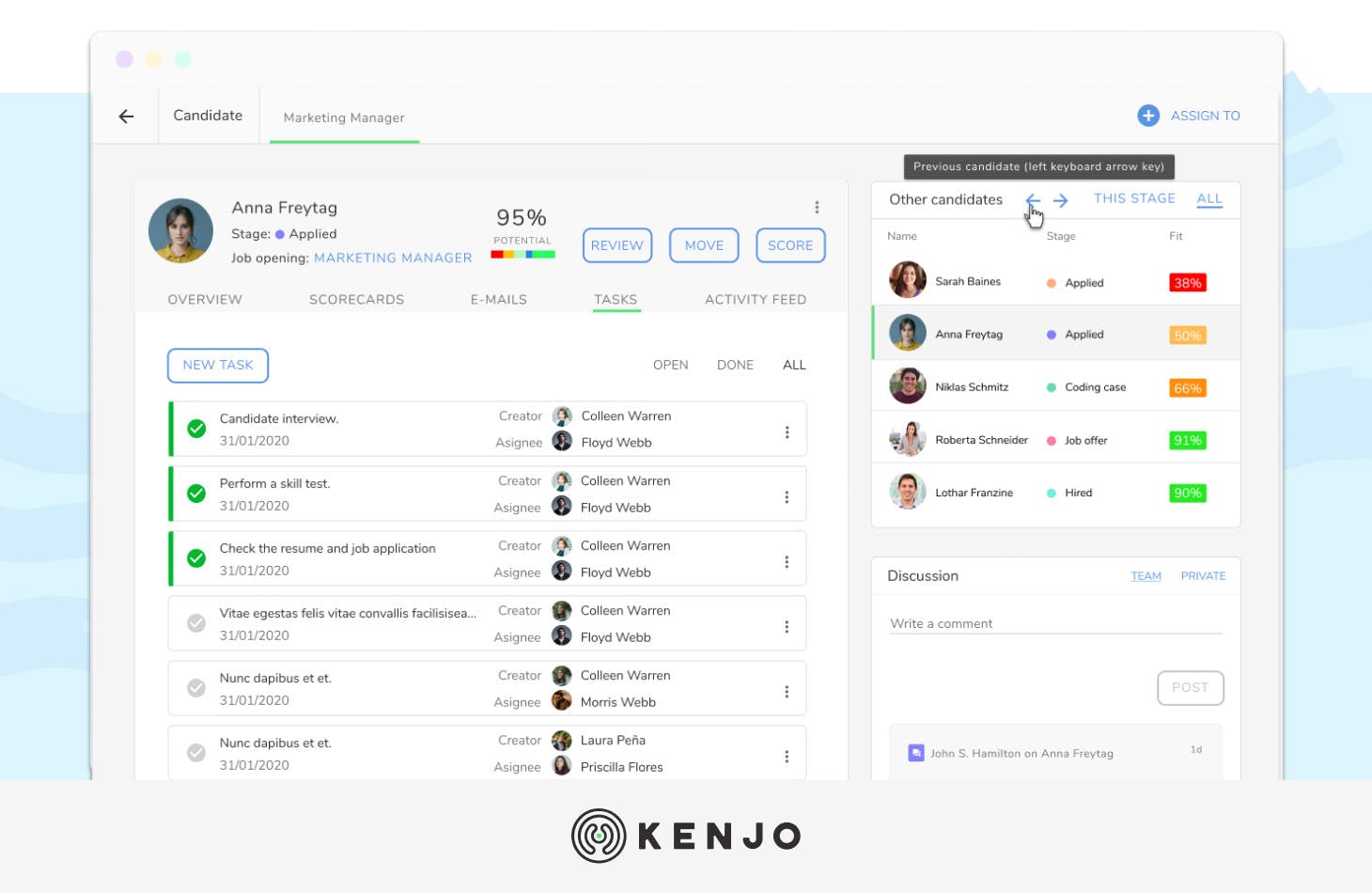
Real-life example of our software
Payroll solution
Payroll is a complicated area, and there are many software companies and service professionals who can help you streamline a process that takes up so much of HR's time. The most important thing to consider when choosing payroll software is to decide which stage of the payroll process you need help with:
- The first stage involves collecting the information that affects each employee's payslip. At this stage, you need a payroll adjustment software.
- In the second stage, the payslips themselves are generated. For this, you need a software that prepares payslips, but you need a technically-minded team member for this.
Kenjo's payroll adjustment feature focuses on the first phase. It enables you to collect all payroll adjustments so that you can then generate payslips (via software all through an agency).
Work climate
The climate is one of the factors with the most significant influence inside a company. A negative working atmosphere increases absenteeism, staff turnover and hinders talent acquisition. In contrast, happy employees are more creative, more productive and more committed to the company. How do you measure well-being in your workforce? Send workplace surveys at regular intervals.
Employee surveys provide you with customisable questionnaire templates that you can automate. And the information gathered appears in the dashboard, making it easier for you to draw conclusions.
Employee satisfaction
As we mentioned earlier, software today enables you to create satisfaction surveys to measure your employees’ happiness and well-being. You can use predefined questionnaires or customise them if you want to analyse one aspect in particular. These are, of course, anonymous and almost always provide a free-text comments field so that the employee can provide extra information if they wish.
The way you collect and store employee information is critical. Having a report that measures the company's pulse is vital for planning initiatives in both the short and long-term. At Kenjo, for example, we use software to gauge the work climate in real-time. Here is a snapshot of the work climate at Kenjo at the time of publishing this article.
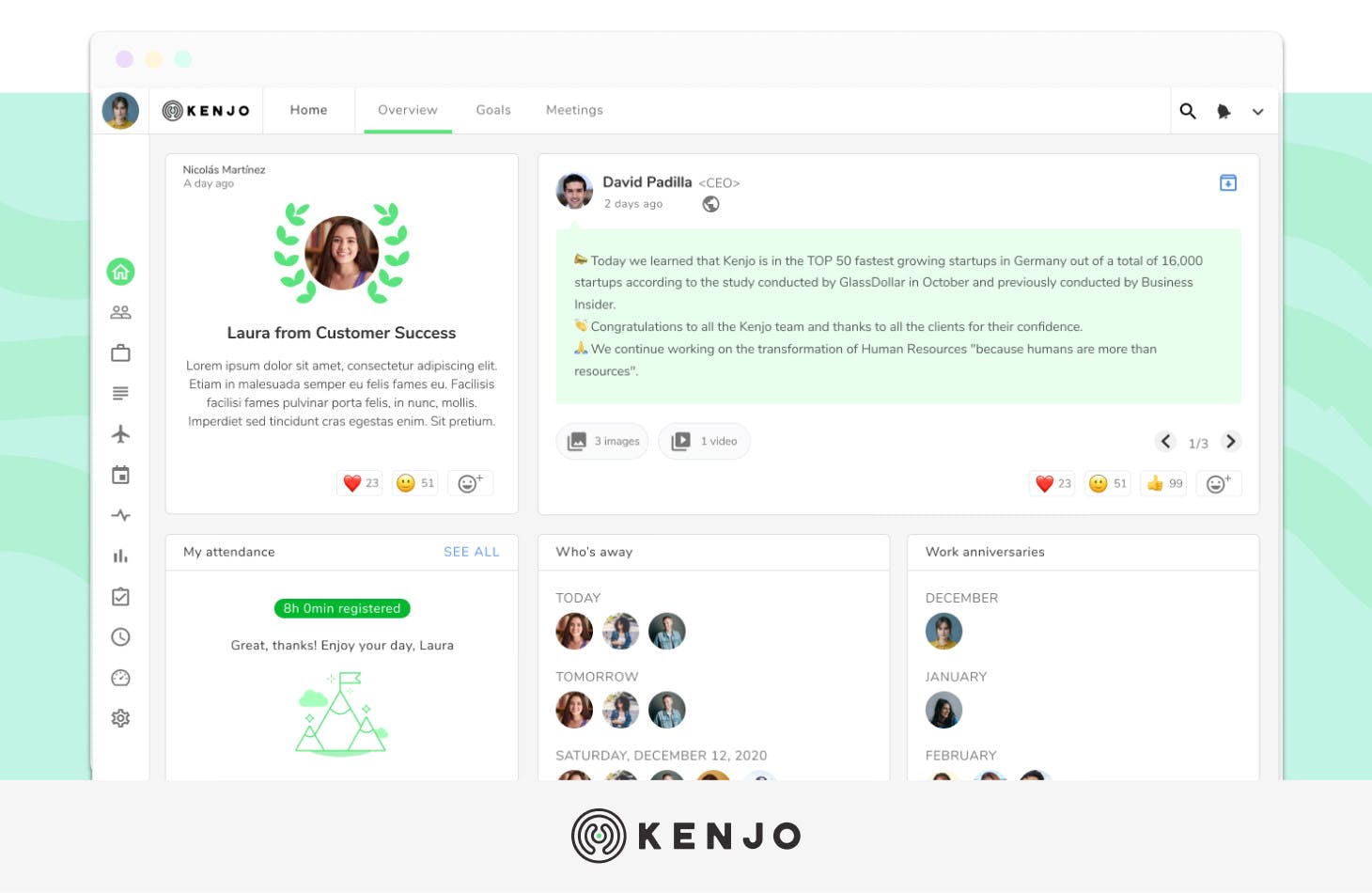
eNPS
The eNPS, or Employee Net Promoter Score is a metric that companies use to measure employee loyalty. There’s a straightforward way to discover this: ask your employees how likely they are to recommend a friend to your company as a place to work. Questions are answered on a scale of one to 10 to arrive at an average.
There’s a very straightforward way to get this data (a simple email is sufficient) and gives you a very realistic view of your employees’ satisfaction levels. You can also track its evolution and see whether the various initiatives the company introduces are making an impact.
HR reporting and analysis
The human resources department has increasing strategic influence within the company, and many of the decisions it makes have a direct effect on business objectives. And this is why it's crucial to make decisions based on real and updated information.
Nowadays, human resources management software includes reports and analytics that enable department heads to create their own dashboards, analyse data and draw conclusions to support their decision-making.
Workflow automation
There are many repetitive manual processes that, thanks to today’s technology, can be automated to lighten your team's workload so that they can spend time on more strategic tasks.
It's therefore essential to choose HR software system which enables you to customise workflows. One that allows new employees to upload their information to assist directly, for example. These are small tasks that, once they are taken care of, will help you get the most out of the time you have.
Automations for workflows
Within workflows, you can also set up automated actions that alleviate the team's workload as well as improve the employee experience. For example, you can also programme automatic emails to everyone who has a job vacancy, updating them on the selection process. So this enables you to offer a more committed and friendlier image, but with minimum effort.
Org Chart
An organisational chart, or organogram, is a visual representation of a company’s structure. It illustrates who reports to who, who belongs to a certain department, etc. This is a handy tool which is worth keeping updated.
Company org chart software offers the functionality to recreate this structure in the digital environment, making it easier to modify and share with the rest of the company.
Employee portal
Employee portals are extremely useful and also help improve the employee experience. This digital environment enables employees to access key information, such as how many holidays they have left, download payslips, consult the company organogram, etc.
This is a handy tool for employees, who can easily access information that’s relevant to them without having to ask HR for it. But it’s even more convenient for the personnel department as the number of queries they receive from employees will plummet.
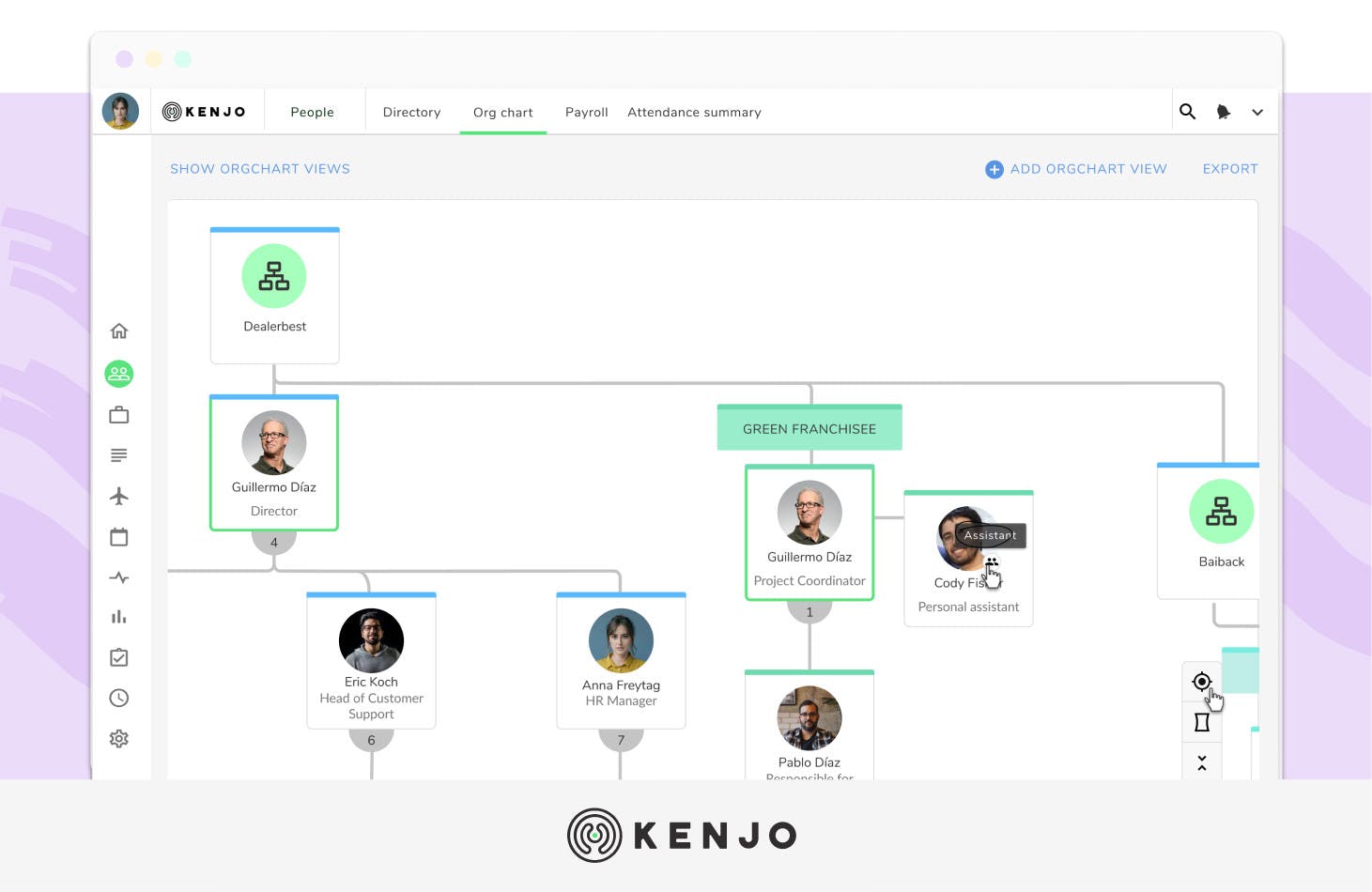
Real-life example of our software
Document manager
Many cloud HR software platforms also act as online filing systems as they enable you to store documents and share them with employees. So, instead of using storage systems, the company can integrate this under one single platform and guarantee that the information is secure and available whenever needed. This is particularly useful for storing employee payslips, for example.
Digital employee file
In the same way, all employee information is stored in the cloud: contact information, salary history, promotions, etc. You can create a file for each one, and department managers can consult them in just a few clicks.
The best HR software on the market
By now, you can appreciate the wide range of features offered by HR software for small businesses. So, it's essential to find one that combines as many of these as possible. That way, you’ll reap the benefits of selecting a comprehensive and efficient solution.
But how do we choose from the different options on the market? These are the best HR software on the market:
Kenjo, the all-in-one HR software
Kenjo is one of the most powerful HR software systems and can help you save up to 40% of the time spent on administrative tasks. This includes all the features an HR department needs to streamline its day-to-day processes:
- Absence and leave management.
- Attendance.
- Employee portal.
- Onboarding.
- Performance management.
- Applicant tracking system (ATS).
- Workflows.
- Org charts.
- Payroll.
- Reporting and analytics.
Plus, all this is integrated into a single cloud-based solution which means you can access it from any device with an internet connection.
E-volution, a people management solution
This is another cloud-based software that simplifies and automates some of the payroll and people management processes. One of the main benefits of this system is that you can set parameters to determine employee remuneration, which ensures you have an equitable and consistent approach. The information is also updated in real-time. You can, therefore, obtain the most recent data about performance, objectives, skills, etc.
Workday, finance software
The main difference of this system is that it includes an ERP Finance module, which enables you to combine both areas in the same platform.
The HR element includes some of the most relevant features: reports and analytics, payroll, time tracker and absence and leave management.
Nevertheless, it’s worth noting that this software is geared towards large multinationals with over 1000 employees.
HiBob
This American all-in-one software focuses specifically on corporate culture. It’s the equivalent of Kenjo in the US.
How much does HR management software cost?
Cloud HR platforms are increasingly adhering to the business model known as SaaS (Software as a Service). This means that users can connect through the internet without buying a physical product, and the company pays a fixed fee per employee. As a result, the price is flexible and adapts to the size of your business. The more employees you have, the higher the cost. On the other hand, if you're a small business with 10 employees, you'll have access to comprehensive and high-quality service at a much smaller fee.
Online HR software prices vary significantly because they usually offer different subscription plans depending on the features you want to use. Prices generally vary from 3€ to 6€ per employee. So, a company with ten employees would pay between 35€ to 45€ a month.
Our Kenjo HR software calculator will give you an idea of how much all the features mentioned here would cost.
The Kenjo price calculator
To calculate a price for you, tell us a little about your company.
Save 10%
YEARLY
MONTHLY
How many people work in your company?
Choose your plan
Do you need an extra feature (Add-on)?
Recruitment (Monthly):
Add-on
Create customised career sites, Manage and automate open positions, interviews and selection processes with our ATS.
Recruitment PLUS (Monthly):
add-on
All features of Kenjo's recruiting module + a native integration that can help you post jobs and hire from 100+ job boards
Your price per month
SUBSCRIPTION
PER MONTH
Plan
StarterEMPLOYEES
Discount
00ONE TIME PAYMENT
Onboarding
Starting from
An English-speaking support agent will help you and your team to implement the tool by following a structured onboarding process. Afterwards, our support lines will always be open to answer your queries.
It’s also worth remembering that HR management software companies usually offer discounts when you opt for a yearly plan, instead of paying month-by-month. This means that companies can obtain a lower fee if you commit for one year.
The cost of buying software is, inevitably, an important factor in your decision-making process. But it’s just as important to weigh up the time-saving potential for your human resources team.
Key factors when choosing an HR software provider
The supplier is another factor that deserves close scrutiny when choosing an HR software. There are certain things you should check out to guarantee that you’re working with a partner who’ll provide the service you expect.
These are just some of the things to bear in mind:
- The supplier’s experience: in general, you should work with companies who have substantial experience in the sector. For example, you can find out which companies have worked with them, for how many years, the size of the company, etc. This will give you some idea of their market influence.
- Implementation: introducing any technological solution into a company is far from easy not only from a technical point of view but also in terms of training your team. Check that your service provider will give you the help you make the most of the new tool, and as quickly as possible.
- Support: Always ensure they offer a free and ongoing support service. Issues and queries can arise at any time, and it’s vital to solve them quickly.
- Integration: an open API software that can integrate other technologies into your online HR processes. For example, check if they can connect with Slack and Google calendars to synchronise notifications. This is such a handy time-saver.
- Security: Lastly, make sure the company takes the necessary steps to guarantee data security and if they do regular back-ups.

Questions to ask when choosing the best HR software
![]()

